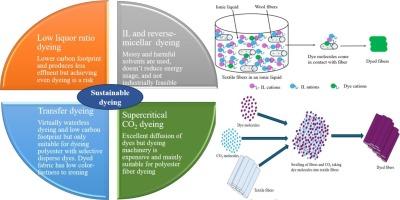全面回顾了染色过程工程和绿色溶剂的进展,以传授可持续纺织制造
IF 9.2
2区 工程技术
Q1 ENERGY & FUELS
引用次数: 0
摘要
纺织印染行业不仅被视为最大的环境污染者之一,而且印染业务的碳足迹也很高。考虑到当前的全球水和能源危机以及实现联合国的可持续发展目标,使纺织材料及其制造具有可持续性是非常必要的。多年来,机械设计、工艺工程和绿色溶剂的开发都得到了改进,以减少能源、水和化学品的使用以及染色对环境的影响。尽管它们具有潜力,但在开发零排放、经济、工业可行和环保的染色方法方面仍存在重大挑战。本文对所研究的各种水、无水可持续染色方法及其染色机理、可回收性、优缺点进行了评述。对不同可持续染色方法染色织物的染色性能和色牢度进行了比较。超临界二氧化碳(scCO2)和十甲基环五硅氧烷(D5)已成为两种最有前途的绿色替代染色介质。离子液体、反胶束和d5染色方法几乎是零排放的,但由于各种问题,包括工业染色机器不是为溶剂染色设计的,需要处理和使用大量有害溶剂,以及一些溶剂很难从染色织物中去除,因此在工业上是不可行的。相反,scCO2基染色主要适用于用分散染料染色聚酯纤维,而不适用于染色棉花、羊毛和其他纤维,因为用于染色的染料不溶于scCO2介质。本综述的研究结果将有助于未来工业上可行的、可持续的、零排放、经济、环保的染色方法的发展。本文章由计算机程序翻译,如有差异,请以英文原文为准。

A comprehensive review of the advances in process engineering and greener solvents in dyeing to impart sustainable textile manufacturing
The textile dyeing industry is not only seen as one of the largest environmental polluters, but dyeing operations also have high carbon footprints. Considering the current global water and energy crisis and to address the UN's sustainable development goals, it is of utmost necessity to make textile materials and their manufacturing sustainable. Over the years, improvements in machinery design, process engineering, and the development of green solvents have been made to reduce energy, water, and chemical usage as well as the environmental impacts of dyeing. Despite their potential, significant challenges remain in developing a dyeing method that is zero-effluent, economical, industrially feasible, and eco-friendly. This review article critically discusses various aqueous and waterless sustainable dyeing methods investigated, along with their dyeing mechanisms, recyclability, merits, and demerits. The dyeing performance and colourfastness properties of the fabrics dyed by various sustainable dyeing methods have been compiled and compared. Supercritical carbon dioxide (scCO2) and decamethylcyclopentasiloxane (D5) have emerged as the two most promising green alternative dyeing media. The ionic liquid, reverse-micellar, and D5-based dyeing methods are virtually zero-effluent but are not industrially feasible due to various issues, including industrial dyeing machines are not designed for solvent dyeing, requiring the handling and use of a large amounts of harmful solvents, and the difficulty of the removal of some solvents from the dyed fabrics. Conversely, scCO2-based dyeing is primarily suitable for dyeing polyester fibres with disperse dyes but is unsuitable for dyeing cotton, wool and other fibres as the dyes used in their dyeing are not soluble in scCO2 medium. The findings of this review will aid in the development of future industrially feasible, sustainable dyeing methods that are zero-effluent, economical, and eco-friendly.
求助全文
通过发布文献求助,成功后即可免费获取论文全文。
去求助
来源期刊

Sustainable Materials and Technologies
Energy-Renewable Energy, Sustainability and the Environment
CiteScore
13.40
自引率
4.20%
发文量
158
审稿时长
45 days
期刊介绍:
Sustainable Materials and Technologies (SM&T), an international, cross-disciplinary, fully open access journal published by Elsevier, focuses on original full-length research articles and reviews. It covers applied or fundamental science of nano-, micro-, meso-, and macro-scale aspects of materials and technologies for sustainable development. SM&T gives special attention to contributions that bridge the knowledge gap between materials and system designs.
 求助内容:
求助内容: 应助结果提醒方式:
应助结果提醒方式:


